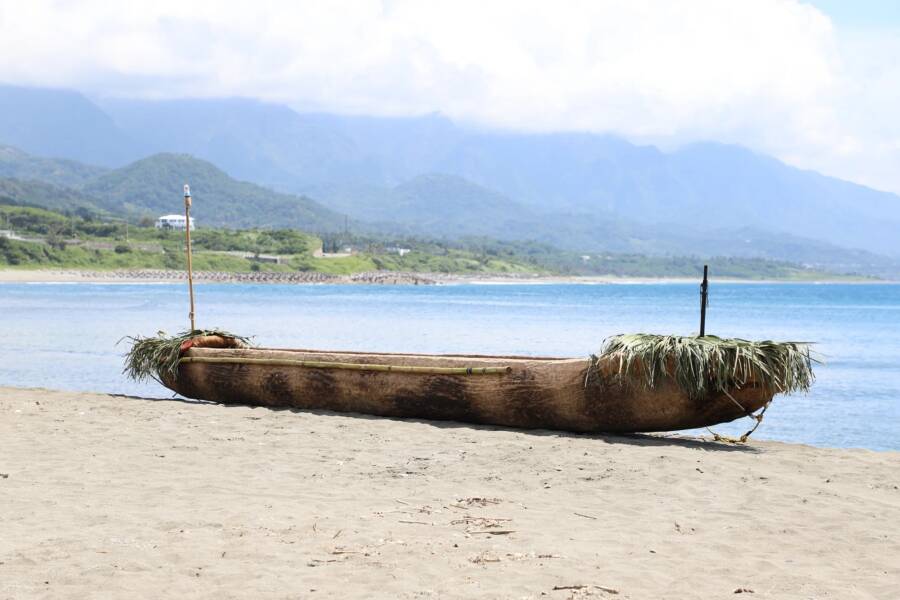Scientists built a primitive canoe using only tools and methods available during the Stone Age to see if they could complete the 140-mile journey early humans made 30,000 years ago.

Yousuke KaifuThe crew completed the 140-mile trip in 45 hours.
Over 30,000 years ago, prehistoric humans made the journey from Taiwan to Japan, crossing 140 miles of open sea. Scientists have long been baffled by how they managed to do so with the tools and knowledge of the time — and now they may have an answer.
A new study published in Science Advances details how a group of researchers built a primitive dugout canoe using only materials and methods that would have been available 30,000 years ago. They then made the treacherous journey across the East China Sea, proving that the trip was indeed possible even during the Stone Age.
Building The Rudimentary Stone Age Canoe
The study and the coinciding canoe voyage are the culmination of years of theorizing and studying prehistoric human migration and travel. “Before our project, no one had seriously considered how this maritime migration occurred,” lead author and University of Tokyo anthropologist Yousuke Kaifu told Scientific American.
Kaifu and his team had previously attempted the journey using rafts, but they proved to be slow, unstable, and too difficult to control in the strong ocean currents of the East China Sea.

Yousuke KaifuResearchers used only tools and methods that would have been available to prehistoric humans to build the canoe.
So, the researchers decided to try again using a dugout canoe. To make the challenge more authentic, they built the vessel the same way as the prehistoric humans who would have originally used them to cross the sea. The scientists used stone axes with wooden handles to chop down a Japanese cedar tree and then carved it into a 25-foot-long canoe they dubbed Sugime.
Then, they launched the canoe from the eastern shore of Taiwan and set their sights on Japan’s Ryukyu Islands.
If this journey was to successfully recreate migrations made tens of thousands of years ago, researchers would need to limit their use of modern technology along the way. So, five experienced paddlers embarked on the multi-day voyage using only the Sun, stars, and ocean swells to guide their way.
“We found that the Paleolithic people could cross the sea with the strong ocean current if they had dugout canoes and were skillful, experienced paddlers and navigators,” Kaifu explained to Reuters. “They had to face the risk of being drifted by the strong ocean current and the possibility that they would never be able to come back to their homeland.”
The 140-Mile Journey Was Not Smooth Sailing
In total, it took the crew over 45 hours to travel from Taiwan to Japan’s Yonaguni Island. For safety, they were accompanied by two modern boats, though the vessels didn’t intervene in any way.

Yousuke KaifuThe 25-foot canoe was carved from Japanese cedar.
The canoe had to cross the Kuroshio in the East China Sea, a portion of the ocean known for having some of the strongest currents in the world. The crew would take breaks from paddling for several hours at a time due to fatigue.
The canoe itself was imperfect. It consistently took on water, which would sit at its base, making it more difficult to paddle.
“Through the project with many failures, we have learned the difficulties of crossing the ocean, and this experience gave us a deep respect for our Paleolithic ancestors,” Kaifu, who followed the journey on one of the accompanying boats, expressed.
This study was just one step in understanding how people over 30,000 years ago made similar journeys. How exactly humans accomplished this voyage in the face of strong ocean currents and the lack of proper navigational tools has long been debated among scientists.

Yousuke KaifuA map of the Kuroshio current, which paddlers had to traverse during their 45-hour journey.
Additionally, people 30,000 years ago would’ve had to cross the Kuroshio when its current was even more powerful than it is today. However, a different study released at the same time indicated that this voyage still would have been possible despite the extreme conditions.
“As our paleo-ocean model simulation showed, crossing the Kuroshio was possible in ancient times, so I believe they achieved it,” Yu-Lin Chang, a physical oceanographer and the lead author of the second study, said. “However, ocean conditions were highly variable. Thus, ancient people may have encountered unpredictable weather conditions during their journey, which could have led to failure.”
After reading about the journey of this primitive canoe from Taiwan to Japan, learn about Thor Heyerdahl and his Kon-Tiki expedition. Then, go inside history’s most famous shipwrecks.





